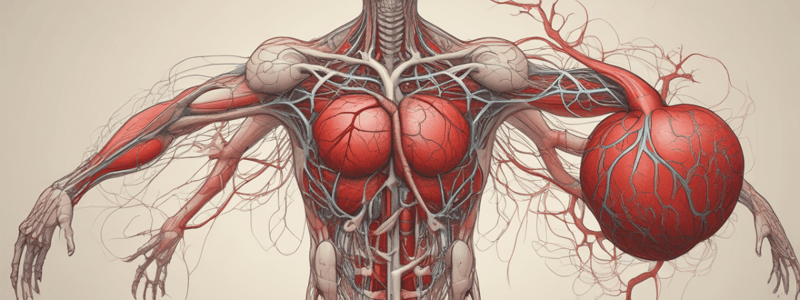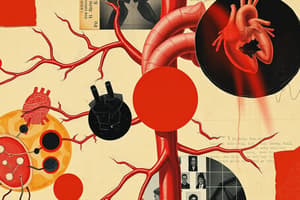Podcast
Questions and Answers
What is the colour of blood when it has a high concentration of oxygen?
What is the colour of blood when it has a high concentration of oxygen?
- Purple
- Red (correct)
- Yellow
- Blue
What is the term for the straw-coloured liquid component of blood?
What is the term for the straw-coloured liquid component of blood?
- Serum (correct)
- Cells
- Plasma
- Platelets
What is the importance of maintaining a narrow range of blood pH?
What is the importance of maintaining a narrow range of blood pH?
- To facilitate blood clotting
- To enable normal chemical reactions (correct)
- To regulate body temperature
- To support the immune system
Which of the following components of blood is responsible for clotting?
Which of the following components of blood is responsible for clotting?
In which type of structures does blood travel?
In which type of structures does blood travel?
Blood is made up of arteries and veins.
Blood is made up of arteries and veins.
The pH of blood can vary widely without affecting its function.
The pH of blood can vary widely without affecting its function.
Blood is blue when it has a low concentration of oxygen.
Blood is blue when it has a low concentration of oxygen.
Red blood cells, white blood cells, and platelets are all found in the serum component of blood.
Red blood cells, white blood cells, and platelets are all found in the serum component of blood.
Blood travels in the heart.
Blood travels in the heart.
The color of blood varies depending on the oxygen concentration: red for oxygen-rich and blue/purple for ______.
The color of blood varies depending on the oxygen concentration: red for oxygen-rich and blue/purple for ______.
Blood pH needs to remain within a narrow range for normal functions to occur, as it affects ______ reactions.
Blood pH needs to remain within a narrow range for normal functions to occur, as it affects ______ reactions.
Serum is the straw-colored ______ component of blood.
Serum is the straw-colored ______ component of blood.
The cells found in blood consist of red blood cells, white blood cells, and ______.
The cells found in blood consist of red blood cells, white blood cells, and ______.
Blood travels in the vasculature through ______ and veins.
Blood travels in the vasculature through ______ and veins.
Match the following characteristics of blood with their descriptions:
Match the following characteristics of blood with their descriptions:
Match the following components of blood with their functions:
Match the following components of blood with their functions:
Match the following characteristics of blood with their respective colours:
Match the following characteristics of blood with their respective colours:
Match the following components of blood with their locations:
Match the following components of blood with their locations:
Match the following statements with their correct explanations:
Match the following statements with their correct explanations:
What does the term 'hypoxaemia' refer to?
What does the term 'hypoxaemia' refer to?
What is the root 'hyper-' used to indicate in medical terms?
What is the root 'hyper-' used to indicate in medical terms?
What does the term '-aemia' suffix indicate in medical terms?
What does the term '-aemia' suffix indicate in medical terms?
Which of the following terms is used to describe low tissue oxygen levels?
Which of the following terms is used to describe low tissue oxygen levels?
What is the meaning of the root 'capnos' in the term 'hypercapnea'?
What is the meaning of the root 'capnos' in the term 'hypercapnea'?
What does the prefix 'hypo-' mean in medical terms?
What does the prefix 'hypo-' mean in medical terms?
What is the term for high CO2 levels in the blood?
What is the term for high CO2 levels in the blood?
What does the suffix '-aemia' indicate in medical terms?
What does the suffix '-aemia' indicate in medical terms?
What is the term for low oxygen levels in tissues?
What is the term for low oxygen levels in tissues?
What does the root 'ox-' mean in medical terms?
What does the root 'ox-' mean in medical terms?
Flashcards are hidden until you start studying




